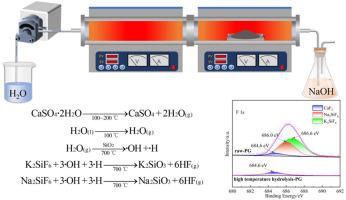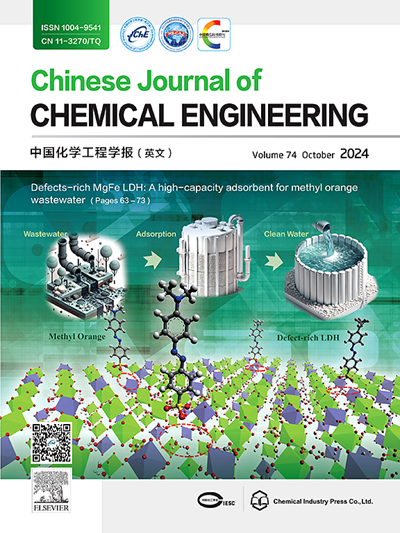蒸汽气氛下磷石膏热处理除氟的研究
IF 3.7
3区 工程技术
Q2 ENGINEERING, CHEMICAL
引用次数: 0
摘要
研究了以蒸汽为反应介质对磷石膏中氟杂质的脱除。系统考察了反应气氛、温度、时间和蒸汽速度对F杂质去除的影响。结果表明,在蒸汽速度为0.0184 m·s−1、反应温度为700℃、反应时间为60 min的条件下,F的去除率可达95.87%。对除氟机理的进一步研究表明,蒸汽和SiO2协同增强除氟作用,对提高除氟效率起着至关重要的作用。基于缩核模型(SCM)的脱氟动力学分析表明,内部扩散是脱氟过程的速率控制步骤,其活化能为30.12 kJ·mol−1。本研究确定了PG除氟的最佳条件,并提出了除氟机理,有助于对PG热处理除杂的理论认识。本文章由计算机程序翻译,如有差异,请以英文原文为准。

Study of defluorination by thermal treatment of phosphogypsum under steam atmosphere
This study investigates the removal of fluorine (F) impurities from phosphogypsum (PG) using steam as the reaction medium. The effects of the reaction atmosphere, temperature, time, and steam velocity on F impurities removal were systematically examined. The results showed that with a steam velocity of 0.0184 m⋅s−1, a reaction temperature of 700 °C, and a reaction time of 60 min, the F removal rate reached 95.87%. Further investigations into the defluorination mechanism revealed that steam and SiO2 synergistically enhance fluoride removal, playing a crucial role in improving the defluorination efficiency. Kinetic analysis of the defluorination process, based on the shrinking core model (SCM), indicated that internal diffusion is the rate-controlling step, with the activation energy of 30.12 kJ·mol−1. This study identifies optimal conditions for PG defluorination and proposes a defluorination mechanism, contributing to the theoretical understanding of impurity removal through the thermal treatment of PG.
求助全文
通过发布文献求助,成功后即可免费获取论文全文。
去求助
来源期刊

Chinese Journal of Chemical Engineering
工程技术-工程:化工
CiteScore
6.60
自引率
5.30%
发文量
4309
审稿时长
31 days
期刊介绍:
The Chinese Journal of Chemical Engineering (Monthly, started in 1982) is the official journal of the Chemical Industry and Engineering Society of China and published by the Chemical Industry Press Co. Ltd. The aim of the journal is to develop the international exchange of scientific and technical information in the field of chemical engineering. It publishes original research papers that cover the major advancements and achievements in chemical engineering in China as well as some articles from overseas contributors.
The topics of journal include chemical engineering, chemical technology, biochemical engineering, energy and environmental engineering and other relevant fields. Papers are published on the basis of their relevance to theoretical research, practical application or potential uses in the industry as Research Papers, Communications, Reviews and Perspectives. Prominent domestic and overseas chemical experts and scholars have been invited to form an International Advisory Board and the Editorial Committee. It enjoys recognition among Chinese academia and industry as a reliable source of information of what is going on in chemical engineering research, both domestic and abroad.
 求助内容:
求助内容: 应助结果提醒方式:
应助结果提醒方式:


